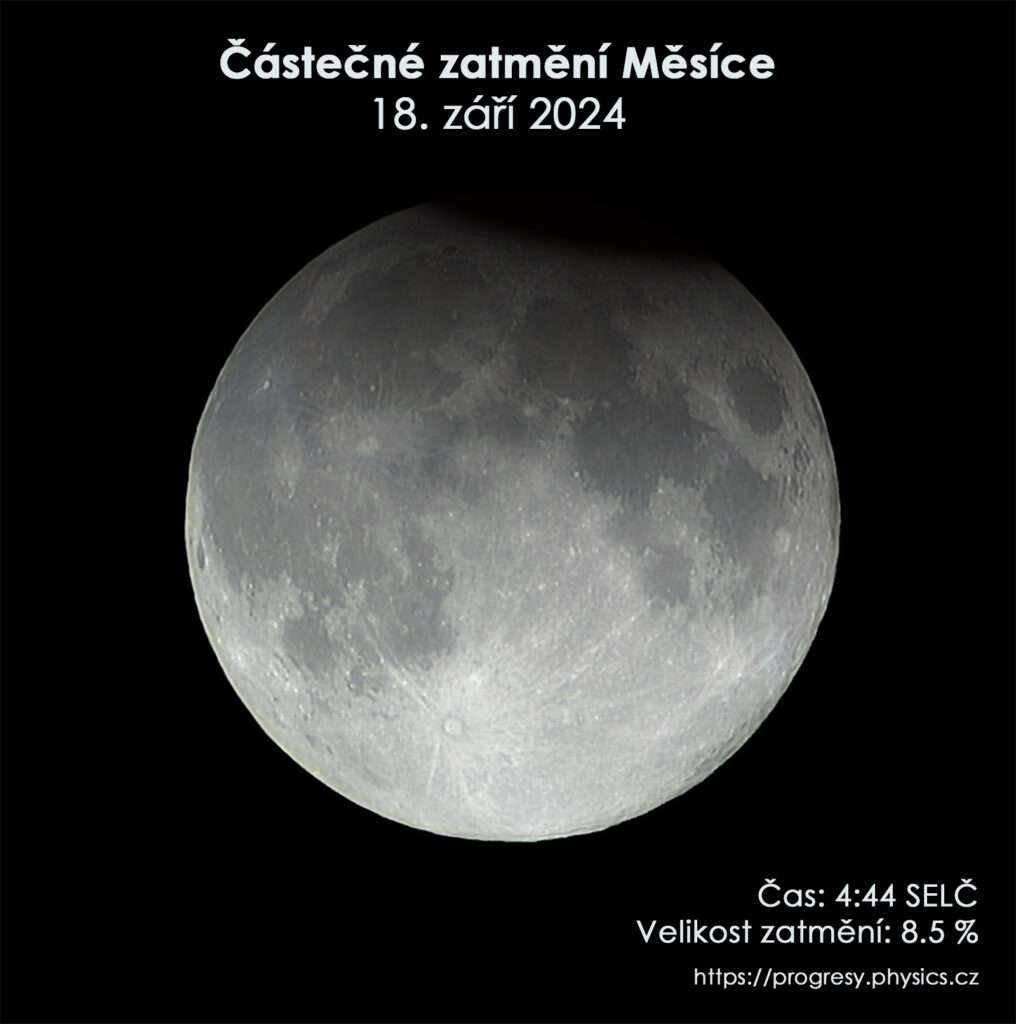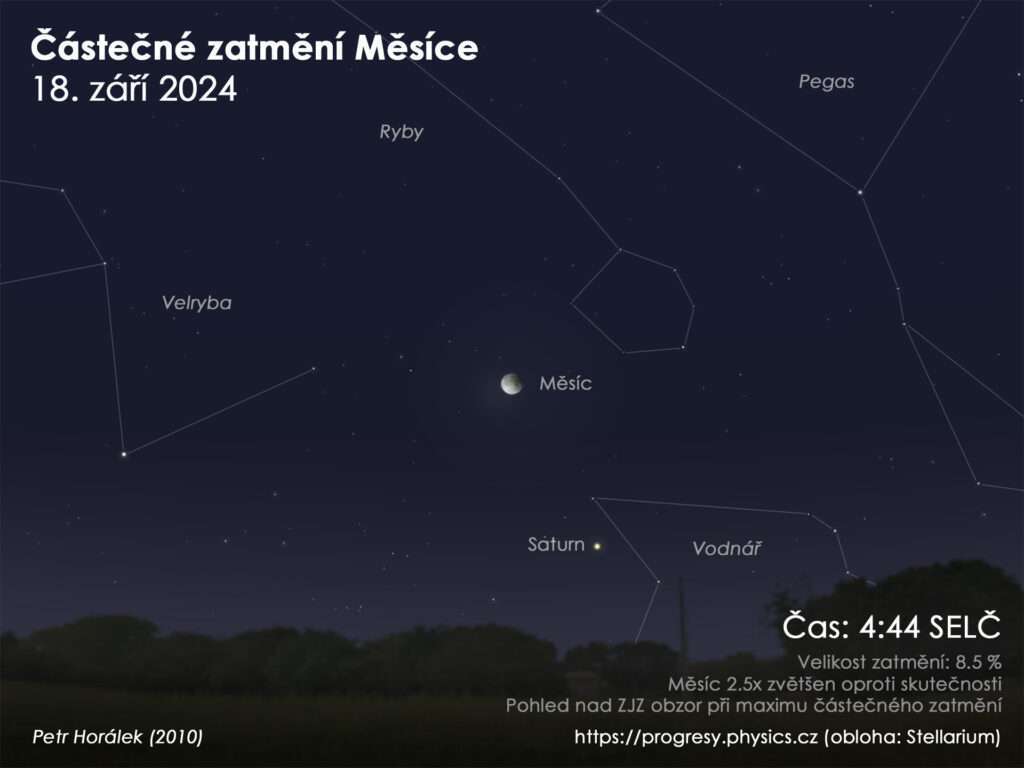A partial lunar eclipse will occur in the early hours of Wednesday 18 September 2024. It will be small, but very visible. The viewing conditions will be favourable - the Moon will not set until the penumbra phase of the eclipse, which is not visible to the eye, so we will be able to see the whole eclipse.
How does a lunar eclipse occur?
A lunar eclipse occurs when our cosmic neighbour passes through the Earth's shadow. Theoretically, the phenomenon should occur whenever the Moon is full and is on the exact opposite side of the sky from the Sun. However, there will be a maximum of four lunar eclipses per year (counting the faint penumbral eclipses). This is due to the fact that the Moon's orbit is inclined by about 5° to the plane of the Earth's orbit and the Earth's shadow in the sky covers a circular area with an angular diameter of only 1.5° at the distance of the Moon. Therefore, the moon's shadow is more likely to miss the earth and no eclipse will occur.
If the full moon is less than its angular diameter from the Earth's shadow, we can see a penumbral eclipse. If an astronaut were standing on the inverted side of the moon at that moment, he would see the sun partially obscured by the dark earth, enveloped by the orange-red ring of our atmosphere. The penumbral eclipse is visible to the eye only when the Moon is close to the Earth's shadow. It then looks as if someone has smoked the full moon with black smoke from the edge. A partial eclipse is more noticeable. In this, the lunar disk is partially immersed in the full shadow of the Earth. And that's what we're going to see on September 18th.

Simulation image of the maximum phase of the lunar eclipse on 18 September 2024. Source: Petr Horálek/FÚ in Opava/Stellarium
How will the lunar eclipse take place on September 18?
Before the eclipse itself, we will observe a classic full moon all night, accompanied by the bright planet Saturn in its vicinity. It is not until the early hours of the morning that the Moon first approaches the Earth's penumbra (at 2 hours 41 minutes CEST; this phase is not visible to the eye). The darkening of the Moon from its upper edge is not noticeable to the eye until before 4 am. The moon will look as if it were enshrouded in black smoke from above. The phenomenon will grow stronger and at 4 hours 12 minutes CEST, the partial lunar eclipse will begin. At that time, we will find our cosmic counterpart about 20° above the southwest horizon.

A simulation image of the sky during the maximum phase of the eclipse on 18 September 2024. The planet Saturn will also be west of the Moon. Source.
Maximum eclipse phasewhich will "bite off" about 8.5 percent of the diameter of the lunar disc from the upper right edge, occurs at 4:44 a.m.. The moon is about 15° above the west-southwest horizon. Just 3° east of the lunar disk we find the planet Neptune in the telescope and 9° west of Saturn visible to the eye. High above the southern and southeastern horizons, the planets Jupiter (in Taurus) and Mars (in Gemini) will be in their winter constellations.
The partial lunar eclipse will end at 5:15 CEST...when it will also be dawn. The entire partial eclipse will last 1 hour 3 minutes. After this phase of the phenomenon, the Moon will slowly rise from the Earth's penumbra and sink towards the western horizon. It will still be slightly darker from the right edge and visually the penumbral eclipse can be observed for about 20 minutes, i.e. until about 5 hours 35 minutes CEST. The full eclipse will be over the horizon only in the western half of the Czech Republic, but the most prominent part of the eclipse (the partial eclipse and the eye-visible phases of the penumbral eclipse) will be observable everywhere in the Czech Republic.
Eclipse over the Czech Republic
| Beginning of the penumbra phase * | 02 h 41 min 02 s CEST |
| The beginning of the partial eclipse | 04 h 12 min 48 s CEST |
| Maximum eclipse phase (8.5 %) | 04 h 44 min 10 s CEST |
| The end of the partial eclipse | 05 h 15 min 35 s CEST |
| End of the penumbra phase * | 06 h 47 min 18 s CEST |
| Moonset (Prague) | 06 h 52 min CEST |
* this phase is observable just before and just after the partial eclipse phase
How to observe the phenomenon?
No special equipment is needed to observe a lunar eclipse - the phenomenon is observable with the naked eye even without binoculars. However, if you have a small telescope, such as a triad, you can get a better view of the lunar craters and discover that the part of the Moon that is in the Earth's shadow is not completely dark, as even this part is hit by weak rays of sunlight refracted in the Earth's atmosphere.
If it is not completely clear and the sky becomes covered with a fine layer of clouds during the observation (unless it is completely cloudy), the phenomenon can still be observed. Even the clouds themselves passing in front of the Moon can create interesting phenomena, as they scatter the lunar radiation on the water droplets or ice crystals of which they are made, usually providing conditions for, for example, the formation of a halo around the Moon, an atmospheric corona, and so on. The passage of a thin cloud can make the spectacle even more dramatic and photogenic. Incidentally, you can also try to photograph the phenomenon with the landscape. If the weather permits, it is worth planning your photography in advance so that the low-lying eclipsed moon is behind, for example, a castle, a distant tree, a mountain peak, etc. A composition with a distant object on the horizon can yield a very successful photographic catch. Photographers can also submit their images to the Captive Space competition, details here: https://knihovna.obecmokre.cz/v-zajeti-vesmiru.
Optical illusion over the horizon
During the phenomenon we can also witness an interesting optical illusion. The moon will be quite low on the horizon at the time of the event, so it may appear larger. This is due to an optical illusion in which our brain compares the size of the Moon with distant objects on the horizon. At the time of the eclipse, we will observe one of the year's larger full moons - just under 11 hours after the eclipse's peak, the moon will be closest to Earth, at a distance of just 357,283 km, thus earning the non-astronomical but familiar label of "super-full" - but that's not nearly as related to the impression of a "big" moon as the optical illusion.
The next partial lunar eclipse in our country will take place on March 14, 2025. From our territory in less than a year, 7 September 2025 in the late evening at dusk and early night we will see a total lunar eclipse, one of the longest of the decade.
Short video about this eclipse with guide Petr Horálek:
Astronomical mouthAV AV of the Czech Republic/ gnews - RoZ_07



